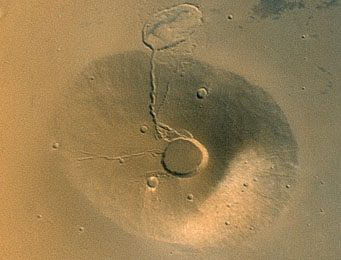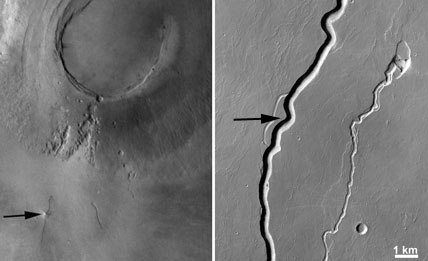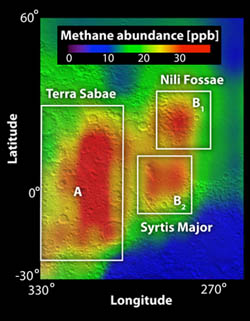Among its many geologic wonders, Mars is home to Olympus Mons, an Arizona-size mountain that ranks as the largest and tallest volcano in our solar system. In fact, half of the Red Planet's surface is covered by volcanic materials of one sort or another — part of Elysium Mons is capped by a single lava flow roughly the size of Oregon.

This view, taken by Mars Global Surveyor in 2002, shows Ceraunius Tholus, an ancient Martian volcano about 16 miles (25 km) across. Its southeastern (lower-right) slope is covered with light-toned dust left over from a global dust storm in 2001. Click here for a larger view.
Malin Space Science Systems
But Mars's days as a eruptive wonderland appear to be over. Yesterday researcher Ken Edgett announced that a 15-year search for any hint of fresh eruptive activity has come up empty. "It looks more and more like there are no active volcanoes or geysers on Mars today," he said, and nothing's spouted off within the past 10 million years. Volcanically, at least, Mars appears to be dead.
Based on evidence Edgett presented at the 2010 meeting of the American Astronomical Society's Division for Planetary Sciences, it's not likely that something's been overlooked. He and seven colleagues at Malin Space Science Systems have scrutinized thousands of high-resolution images taken with cameras on NASA's Mars Global Surveyor and Mars Reconnaissance Orbiter. As of late September, these spacecraft have recorded 62% of the planet's surface down to a resolution of 20 feet (6 m) per pixel.
"We've looked really hard, and we're still looking," said Edgett, clearly disappointed by the negative results.

In 1977 the Viking 1 orbiter spotted a suspicious white puff (left) near the caldera-topped summit of Arsia Mons on Mars. But a 2007 close-up taken by the Mars Reconnaissance Orbiter (right) shows no hint of a volcanic eruption at that location.
NASA / Malin Space Science Systems
Over the years the MSSS geologists have scrutinized every known Martian volcano, and they've revisited all the places where other researchers had noted suspect surface features. One curious puff of "smoke," first spotted in 1977 by a Viking Orbiter, proved to be nothing more than transient dust cloud. A strange arc of dark material in an area of known volcanic flows revealed itself, on closer inspection, to be nothing more than a rough tract of boulders.

Red areas indicate where in 2003 ground-based observers detected concentrations of methane in the Martian atmosphere, measured in parts per billion (ppb). Click on the image for an expanded view.
NASA / M. Mumma & others
Geologists gauge the age of a planet's surface, in part, by noting how many small craters it bears. But across Mars, Edgett explains, dust is piled up so deeply that small craters can often form on a lava flow that later, literally, get blown away — giving the impression that the flow is very young when it's really quite old.
Astrobiologists have been hoping that occasional spurts of volcanism could heat up enough of the Red Planet's frozen landscape to create and even maintain what research Bruce Jakosky calls "warm havens for life." Others are seeking the source of methane gas that's been identified in the planet's thin atmosphere. And some Martian meteorites clearly came from geologically recent lava flows.
So the search goes on, but the odds of finding a fresh eruption are getting very long.
 1
1
Comments
Gutierrez23Jo
August 15, 2011 at 5:21 pm
Different people in the world get the loan in various creditors, just because this is fast and easy.
You must be logged in to post a comment.
You must be logged in to post a comment.